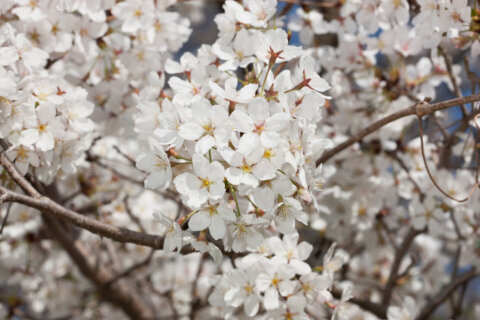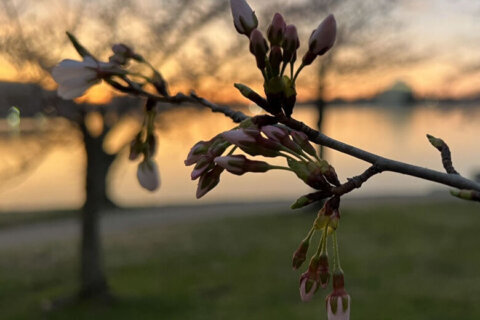The iconic cherry blossom trees around the Tidal Basin and National Mall in D.C. reached peak bloom early on Sunday, nearly breaking the record for the earliest peak bloom in history, according to the National Park Service.
But what could be behind the trend?
After a spout of unseasonably warm weather, the National Park Service announced the trees had reached peak bloom ahead of schedule on Sunday afternoon. (This year’s peak bloom came before the annual National Cherry Blossom Festival even started; it runs from March 20-April 14.)
PEAK BLOOM! PEAK BLOOM! PEAK BLOOM! Did we say PEAK BLOOM?!
The blossoms are opening & putting on a splendid spring spectacle. See you soon.
🌸🌸🌸🌸🌸🌸! https://t.co/h04Gu0ksc1 #CherryBlossom #BloomWatch #WashingtonDC pic.twitter.com/ElYKjPB3UH— National Mall NPS (@NationalMallNPS) March 17, 2024
Washington Post contributor Kevin Ambrose told WTOP that the Park Service expected peak bloom to begin between March 23 and March 26, but recent weather trends have brought the buds out much sooner.
“If you look at the trends over the past 10, 20 years, the blooms have been blooming about a week earlier than in the past. So definitely there’s a trend, probably with climate change, I would imagine,” he said.
Ambrose said the clearest impacts of climate change on the cherry blossoms can be seen when taking a look at one of the Tidal Basin’s most iconic trees: Stumpy.
“If you track ‘Stumpy,’ the famous distressed cherry tree on the Tidal Basin, the water level has risen about a foot in the last 10, 20 years. And the trees, including Stumpy, on the southern bank, go underwater for most high tides. And that’s definitely related to climate change and sea levels,” Ambrose told WTOP.
Sunday’s peak bloom announcement from the National Park Service comes just days after the department announced the removal of 140 cherry trees for a critical, three-year sea wall repair project.
“The sea walls are no longer structurally sound and threaten visitor safety and the historic setting, including the cherry trees around the Tidal Basin,” the park service said.
Officials said the $113 million sea wall restoration project will help manage rising sea levels and poor drainage issues as tides get higher around the Tidal Basin.
“We’ve had to take down a dozen or more trees. We have other ones that are clearly in failing health, simply because they’re being overwatered,” NPS spokesperson Mike Litterst told WTOP.
More Cherry Blossom Festival News
- FAQ: What you need to know about the National Cherry Blossom Festival 2024
- Identifying D.C. cherry blossoms: Do you know your Yoshino from your Kwanzan?
- Enjoy D.C. cherry blossoms from a private hot tub or tiki bar — on the Potomac
- Miles from the Tidal Basin, an alternative for cherry blossom lovers
The park service’s announcement about the flowers came on a day when crowds of people were already downtown to see the trees — which were a gift from the mayor of Tokyo in 1912.
Peak bloom is defined as the point when 70% of the blossoms on the 3,700 Yoshino cherry trees around the Tidal Basin and National Mall are open. Depending on the weather, the trees can peak for up to 10 days, but Ambrose is expecting about a week of peak bloom.
“We have some cool weather next week. I’m guessing we’ll have peak bloom for about seven days, and hopefully, the wind won’t blow the blossoms away too much,” he said. “The warm, hot temperatures usually fade the blossoms the quickest, so a cool week will be good for blossom viewing.”
Sunday’s bloom tied with March 17, 2000, for the second-earliest peak bloom on record. According to the park service, the earliest peak bloom recorded was March 15, 1990. The average peak bloom tends to happen around April 4.
WTOP’s Jessica Kronzer and Cheyenne Corin contributed to this report.
Get breaking news and daily headlines delivered to your email inbox by signing up here.
© 2024 WTOP. All Rights Reserved. This website is not intended for users located within the European Economic Area.









